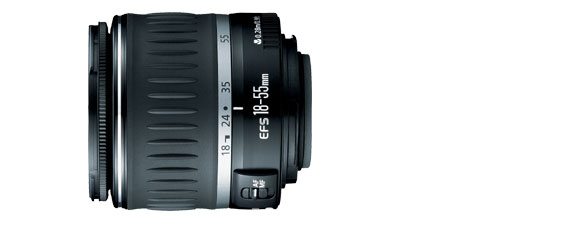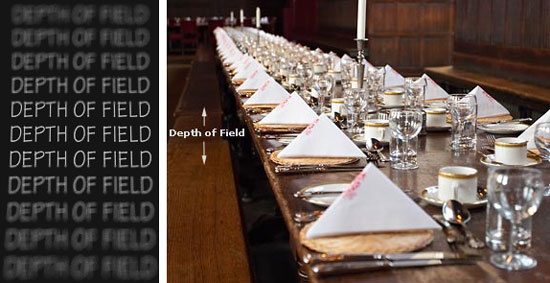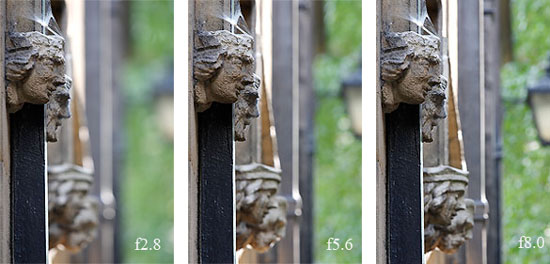Digital Photography from 20,000 Feet
by Wesley Fink on September 25, 2006 12:05 AM EST- Posted in
- Digital Camera
F Stop: The Speed of the Lens
Most buyers today are used to the idea of zoom lenses, and they aren't even aware of how many compromises the common "kit" zoom lens forces on them. The biggest compromise by far is lens speed. Film SLR cameras normally came with a normal lens that was rated at an f-stop of f1.7-1.8, where most zoom lenses are rated at speeds like f3.5-f5.6. What is F-Stop, anyway?
F-stop is the focal length divided by the diameter of the lens. For example, a 200mm f/4 lens will be 50mm wide. 200mm/50mm = f/4. That is why f-stop is typically written as F/4, meaning "focal-length over 4" or "focal-length divided by four".

The aperture scale is like the ISO film speed scale in reverse. Each full F-Stop is half the light of the earlier number, and the LOWER the number the more light the lens can pass. Lenses are marked with a range of f-stops. The maximum light-gathering ability of a lens is determined by the lowest number or f-stop, and the rest of the range is adjustments to reduce amount of light the lens will pass. Look at the f-stop scale:
1 - 1.4 - 2 - 2.8 - 4 - 5.6 - 8 - 11 - 16 - 22 - 32
The progression of f-stops are powers of the square root of 2. This means each number, as it increases in full f-stops, will pass half the light of the previous smaller number.

Let's return to yesterday's typical normal lens at f1.7 and today's standard zoom at f3.5-f5.6. F1.7 to 1.8 is a half f-stop, which is 1.5 times faster than f2.0, and f3.5 is a half f-stop between 2.8 and 4.0. So, under the best circumstances, the f1.7 lens is capable of passing FOUR times the light of the zoom lens. This is under the best circumstances, however, since the f5.6 is the other end of a variable aperture. At the f5.6 end, the f1.7 can pass TWELVE times the amount of light of the f1.7. So if we have a zoom lens that is rated 18-55mm f3.5-5.6, it is capable of passing ¼ the light of the f1.7 at the 18mm side, and 1/12 the amount of light of the f1.7 at the 55mm end of the zoom range. In between the amount varies smoothly from 1/4 to 1/12.
Buyers who wonder why they have trouble taking sharp indoor photos with a standard zoom now have their answer. You will have to crank up the ISO, turn on anti-shake if it's an option, or use a flash to supplement light if you plan to take the typical family indoor photos with a standard zoom lens. Or you could buy a normal lens while there are still some on the market and attach a lens that was designed to shoot images in available light.
Depth of Field
Fast lenses are great, in that they allow you to shoot in lower light than a slower lens. However, there is a price to pay for this low-light capability. All things being equal the faster the lens the shallower the depth of field. What do we mean by depth of field?

Depth of field is the amount of distance between the nearest and farthest objects that appear in acceptably sharp focus in a photograph. A "good" depth-of field is pretty subjective, since a shallow depth of field might be preferred in a portrait of your girlfriend, but a wide depth of field is preferred in landscape shots. A few factors affect depth of field; they are:
1) the diaphragm opening of the lens (the aperture or f-stop),
2) the focal length of the lens in use, and
3) image size (which has a direct relationship to distance from the subject).

The general rule of thumb is the bigger the lens opening (aperture) used (the smaller the f-stop) the more shallow the depth of field.
This means that critical focusing will be required with a large f-stop because when you use a large aperture - in particular when attempting to focus at a nearby subject - the zone of sharpness (DOF) can be very limiting. On the other hand, if extended depth of field is desired, you can just choose a smaller lens opening (larger f-stop like f/8, f/11, f/16, f/22) to extend the plane of sharpness, so everything will be in sharper focus.
Depth of field also increases with distance. This means the farther you place the camera from your subject, the greater the depth of field. Landscapes have great depth of field, while macro (close-up) photographs tend to have very little depth of field because the subject is so close to the lens.
Most buyers today are used to the idea of zoom lenses, and they aren't even aware of how many compromises the common "kit" zoom lens forces on them. The biggest compromise by far is lens speed. Film SLR cameras normally came with a normal lens that was rated at an f-stop of f1.7-1.8, where most zoom lenses are rated at speeds like f3.5-f5.6. What is F-Stop, anyway?
F-stop is the focal length divided by the diameter of the lens. For example, a 200mm f/4 lens will be 50mm wide. 200mm/50mm = f/4. That is why f-stop is typically written as F/4, meaning "focal-length over 4" or "focal-length divided by four".

The aperture scale is like the ISO film speed scale in reverse. Each full F-Stop is half the light of the earlier number, and the LOWER the number the more light the lens can pass. Lenses are marked with a range of f-stops. The maximum light-gathering ability of a lens is determined by the lowest number or f-stop, and the rest of the range is adjustments to reduce amount of light the lens will pass. Look at the f-stop scale:
1 - 1.4 - 2 - 2.8 - 4 - 5.6 - 8 - 11 - 16 - 22 - 32
The progression of f-stops are powers of the square root of 2. This means each number, as it increases in full f-stops, will pass half the light of the previous smaller number.

Let's return to yesterday's typical normal lens at f1.7 and today's standard zoom at f3.5-f5.6. F1.7 to 1.8 is a half f-stop, which is 1.5 times faster than f2.0, and f3.5 is a half f-stop between 2.8 and 4.0. So, under the best circumstances, the f1.7 lens is capable of passing FOUR times the light of the zoom lens. This is under the best circumstances, however, since the f5.6 is the other end of a variable aperture. At the f5.6 end, the f1.7 can pass TWELVE times the amount of light of the f1.7. So if we have a zoom lens that is rated 18-55mm f3.5-5.6, it is capable of passing ¼ the light of the f1.7 at the 18mm side, and 1/12 the amount of light of the f1.7 at the 55mm end of the zoom range. In between the amount varies smoothly from 1/4 to 1/12.
Buyers who wonder why they have trouble taking sharp indoor photos with a standard zoom now have their answer. You will have to crank up the ISO, turn on anti-shake if it's an option, or use a flash to supplement light if you plan to take the typical family indoor photos with a standard zoom lens. Or you could buy a normal lens while there are still some on the market and attach a lens that was designed to shoot images in available light.
Depth of Field
Fast lenses are great, in that they allow you to shoot in lower light than a slower lens. However, there is a price to pay for this low-light capability. All things being equal the faster the lens the shallower the depth of field. What do we mean by depth of field?

Depth of field is the amount of distance between the nearest and farthest objects that appear in acceptably sharp focus in a photograph. A "good" depth-of field is pretty subjective, since a shallow depth of field might be preferred in a portrait of your girlfriend, but a wide depth of field is preferred in landscape shots. A few factors affect depth of field; they are:
1) the diaphragm opening of the lens (the aperture or f-stop),
2) the focal length of the lens in use, and
3) image size (which has a direct relationship to distance from the subject).

The general rule of thumb is the bigger the lens opening (aperture) used (the smaller the f-stop) the more shallow the depth of field.
This means that critical focusing will be required with a large f-stop because when you use a large aperture - in particular when attempting to focus at a nearby subject - the zone of sharpness (DOF) can be very limiting. On the other hand, if extended depth of field is desired, you can just choose a smaller lens opening (larger f-stop like f/8, f/11, f/16, f/22) to extend the plane of sharpness, so everything will be in sharper focus.
Depth of field also increases with distance. This means the farther you place the camera from your subject, the greater the depth of field. Landscapes have great depth of field, while macro (close-up) photographs tend to have very little depth of field because the subject is so close to the lens.










81 Comments
View All Comments
feraltoad - Monday, September 25, 2006 - link
Is providing a single sentence regarding start-up time dwelling? I don't think any camera review is complete without listing startup times and listing shot to shot time. I think it's a bit hypocritical to focus on core architecture, timings and such and then say a length of time I can actually perceive is not relevant. Especially, when you go and provide such a good article. I think you are just trying to make the other review sites seem stodgy and backward or just wrongheaded, and show that AT is "with it". Moreover, you say they speak gibberish like they are jargon slinging photo elitist snobs. Then you provide,IMO, a pretty techical primer, when they probably have some material for novices too. I know you were just saying "We're Cool, We Rule!", but I don't think when ur AT you have to do that. AT is already in my RSS reader because it does quality reviews. I just skimmed the article, and I can't wait to go back and read it in depth. I'me really excited about AT doing photo stuff too. I agree with the above poster that finding some standard meaningful benchmarks with good subjective commentary will have AT ruling the roost in camera reviews. Not to plug another site, but I think Steve's Digicams provides excellent reviews, actually his site is about the only site I really find useful for cameras. I'm glad I will soon have two sites that provide good information. YAY AT!soydios - Monday, September 25, 2006 - link
How does AnandTech review and compare its computer components? With standardized benchmarks and editorial commentary. Compare all the cameras with a good, strong set of standardized tests across the board, and also add a dose of the editorial commentary.In particular, for the sub-$1000 market, I would suggest evaluating the kit as a whole (image quality with kit lens). Personally, I will be picking up a Nikon D50 with the 18-55mm and 55-200mm lenses, and I have researched the heck out of that package, trying to find an AnandTech-esque review.
Venturing above the sub-$1000 (although I would be very intrigued by some reviews of the professional-level equipment) would get very expensive very fast. Perhaps start small, then venture into the almost-pro market (Nikon D200 and Canon EOS 30D, and some of the $500-$1000 lenses), then maybe dip a toe into the professional level, just to let us all see what the real fancy stuff is like (since very few of us will be buying a D2Xs or EOS-1D MkII-N).
Time permitting, I would put out some quick looks at the Nikon D50 and the Canon EOS 350D, with some comparison between the two. A review/comparison of both the Nikon D80 (in the works, good!) and the Canon EOS 400D would be an interesting read.
Again, review the D-SLR market the same way you guys do computer hardware. Avoid the slugfest low-range and the stratospherically-priced high range. Focus on the high-midrange market (the sub-$1000 D-SLR's to start, move up to the $1k-2k market once you gain some feel for differences between cameras). Do across-the-board standardized benchmarks, with some synthetic but more real-world results.
mostlyprudent - Monday, September 25, 2006 - link
Exactly my thoughts. I have spent some time at a number of camera review sites and am always left wondering "Is the Nikon D80 good enough to justify the price difference over the D50?". "What about the Canon EOS 30D? How much better is it then the Nikon D80 or the Rebel XT/XTi?"Maybe these cannot be answered in the same way as CPU and GPU articles, but standardized tests and comparisons would be nice.
Give me some numbers! I don't want to hear "shot-to-shot performance was sluggish compared to higher end cameras"...unless you can quantify that for me.
Lighting is such an improtant part of photography. Standardized indoor lighting under a couple different kinds of lighting situation (i.e. low, bright, fluorescent, etc.). I don't know how to standardize outdoor shots, but it sure would be nice.
bigpow - Monday, September 25, 2006 - link
I'm gonna stick with www.dpreview.com for now if I want to get my digital photography news/articles.AT, stick with PCs, will you?
silver - Monday, September 25, 2006 - link
I don't understand as I usually read more than one site on one subject. For instance I've been reading Tomshardware since it was sysdoc.pair.com and both Anandtech and Extremetech nearly as long.jnmunsey - Monday, September 25, 2006 - link
Geez, you'd think a site like Anandtech would find someone who knows what he's talking about to write this article...soydios - Monday, September 25, 2006 - link
I'm just a photography hobbyist, but I thought that the article covered all the important basics of full-manual general photography and digital photography.I would touch on filters, though. Those can come in handy. Particular onces to focus on: UV ("does it actually do anything, or is it just a lens protector?" debate), Polarizing, and the primary colors (blue, yellow, and red).
soydios - Monday, September 25, 2006 - link
Concerning polarizing filters (I really wish there was an edit functionality for comments): circular polarizing works with autofocus and digital cameras, linear does not.I know AnandTech isn't much of a software website, but a short article on editing software (Adobe Photoshop, beta of Adobe Lightroom, Apple Aperture) would complete the picture. No need to focus on the software or printing, but a photography software article written in the same manner as this one is something that would help me a lot! (I have almost no experience with editing software).
Wesley Fink - Monday, September 25, 2006 - link
We all want to improve, so please provide specifics so we can address them. It would also be helpful if you would provide your photography credentials, so we can know the level of expertise to attach to your comments.kilkennycat - Monday, September 25, 2006 - link
... a first-class and technically-meaty summary of the current status of digital camera technology. Well up to the usual Anadtech standards. Congratulations, Wes. The addition of a Digital Camera section is a superb idea. By all means, use reference charts, lighting and scenes for resolution, optical-distortion, shading and color-fidelity comparison of both lenses and sensors. Just as you have with video cards and CPUs, come up with your own benchmarks if necessary.